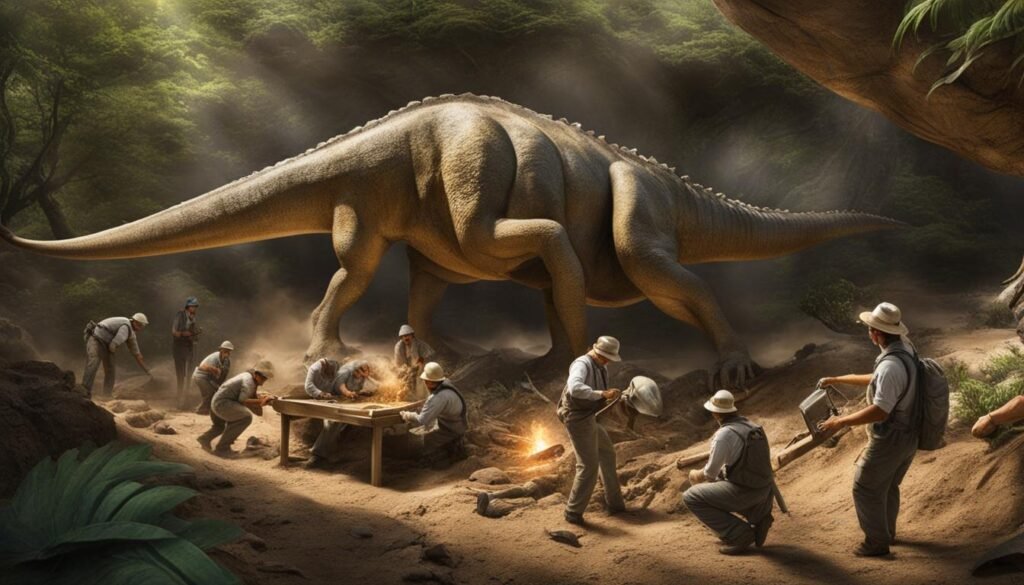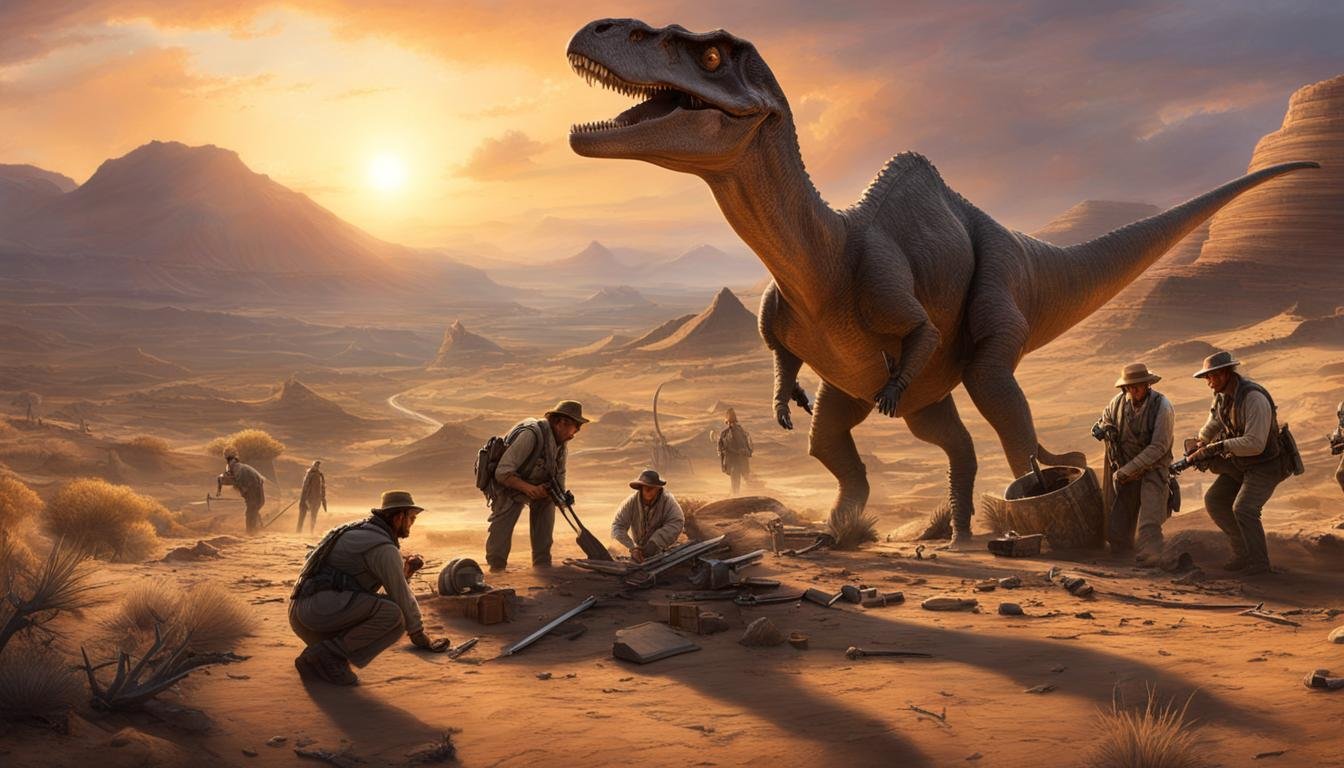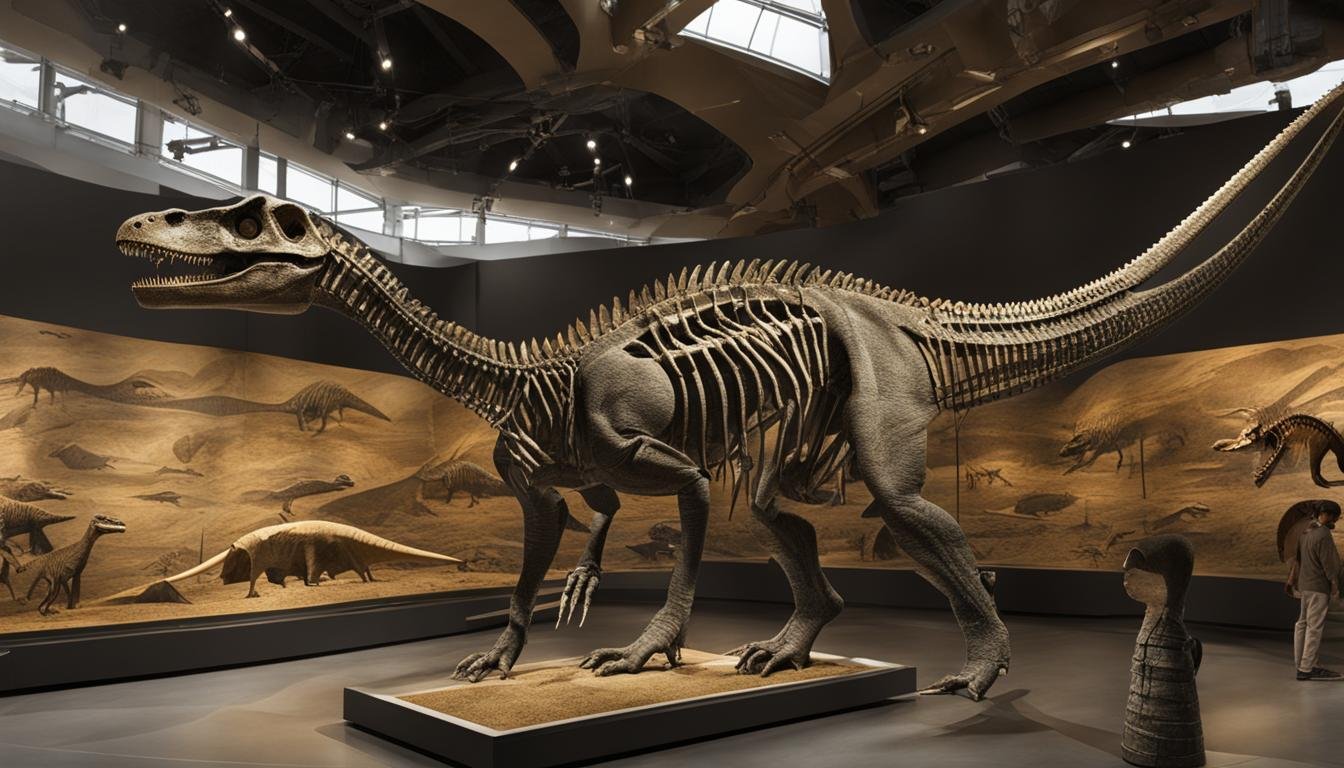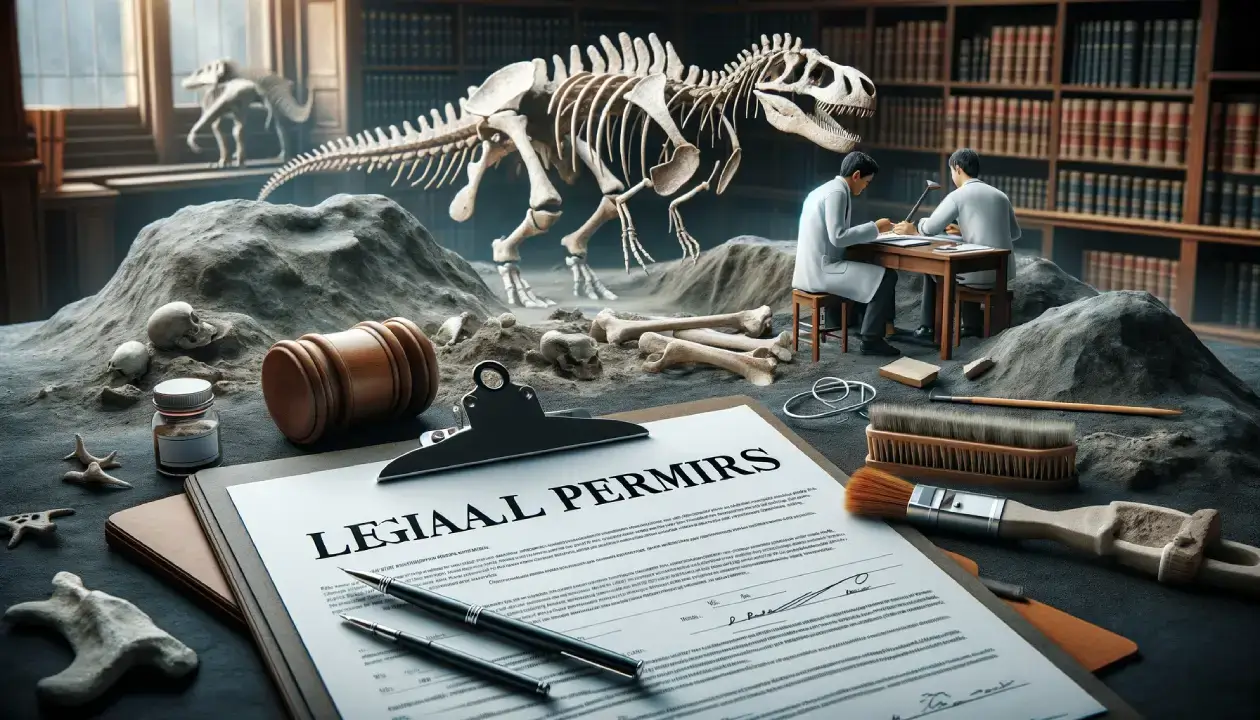Welcome to our article on the conservation and protection of dinosaur fossils! Paleontological heritage preservation and legislation on fossil protection are crucial topics that ensure the longevity and integrity of these invaluable artifacts. In this section, we will explore the importance of legislation and the efforts made by federal agencies to safeguard our prehistoric heritage for future generations.
| Key Takeaways | Details |
|---|---|
| Federal Legislation and Regulations | The Paleontological Resources Preservation Act of 2009 and regulations by the National Park Service under the Code of Federal Regulations play a critical role in the protection of dinosaur fossils on federal lands. |
| Proper Excavation and Conservation Techniques | Techniques like careful digging, documentation, and site management are vital for preserving the integrity and scientific value of dinosaur fossils. |
| Confidentiality and Access Balance | Balancing the confidentiality of fossil locations with public access and scientific research is essential, as outlined in the National Parks Omnibus Management Act of 1998. |
| Ethical Practices in Fossil Collection | Ethical practices, including obtaining necessary permits and adhering to guidelines, are crucial for responsible fossil collection, especially on lands managed by BLM, NPS, and FWS. |
| Collaborations for Fossil Protection | Partnerships between federal agencies, museums, avocational paleontology groups, and the public enhance fossil protection efforts and promote shared resource stewardship. |
Laws and Regulations for Fossil Protection
The Paleontological Resources Preservation Act of 2009 (PRPA) is a crucial legislation that addresses the protection of fossils from federal lands. It specifically directs federal agencies like the National Park Service (NPS), Bureau of Land Management (BLM), and Fish and Wildlife Service (FWS) to manage and safeguard paleontological resources. The PRPA mandates the development of plans for inventory, monitoring, and scientific use of fossils, ensuring their long-term conservation and protection.
The NPS, as part of its efforts to enforce fossil protection regulations, implements the Code of Federal Regulations (C.F.R.) Chapter I. These regulations prohibit the possession, destruction, removal, or disturbance of fossil specimens within national parks. They also establish requirements for research specimen collection permits and the curation of fossil specimens in museum collections. By implementing these regulations, the NPS ensures that fossils are preserved and managed in a responsible and scientific manner.
To provide a comprehensive understanding of the laws and regulations surrounding fossil protection, it is essential to consider the PRPA and the NPS regulations. These legal frameworks play a crucial role in ensuring the preservation and scientific value of dinosaur fossils found on federal lands. By adhering to these laws and regulations, we can protect our rich paleontological heritage for future generations to study and appreciate.
| Legislation | Key Provisions |
|---|---|
| Paleontological Resources Preservation Act of 2009 (PRPA) | – Directs federal agencies to manage and protect paleontological resources – Mandates the development of inventory, monitoring, and scientific use plans for fossils |
| Code of Federal Regulations (C.F.R.) Chapter I | – Prohibits possession, destruction, removal, or disturbance of fossil specimens in national parks – Outlines requirements for research specimen collection permits and curation of fossils in museum collections |
Dinosaur Fossil Preservation: Techniques and Strategies
Preserving dinosaur fossils involves a combination of careful excavation techniques and site management practices. By following these strategies, scientists can ensure the long-term preservation and scientific value of these prehistoric treasures.
Fossil Excavation Techniques
Proper fossil excavation techniques are essential for preserving the integrity and context of dinosaur fossils. Paleontologists carefully dig around the fossils, documenting their position and relationship to surrounding sediment layers. This meticulous process allows scientists to reconstruct the fossil’s original location and gain valuable insights into its environment and behavior.
Additionally, the use of specialized tools such as brushes, dental picks, and small chisels helps prevent accidental damage during excavation. By employing these techniques, paleontologists can extract fossils with precision and minimize the risk of breakage or loss of important anatomical details.
Fossil Site Management
Effective site management plays a crucial role in safeguarding fossil sites from erosion, vandalism, and natural disturbances. Implementing measures such as fencing, signage, and regular monitoring helps protect these valuable paleontological resources.
Moreover, collaboration between scientists, land managers, and local communities is vital for successful site management. By engaging with stakeholders, raising awareness, and promoting responsible visitation, we can ensure the conservation of dinosaur fossil sites for future generations to appreciate and study.
| Benefits of Proper Fossil Preservation Techniques | Challenges in Fossil Preservation |
|---|---|
| 1. Retains the scientific value and integrity of fossils. | 1. Fragility of some fossils, especially those with poor mineralization. |
| 2. Facilitates accurate documentation and interpretation of specimens. | 2. Risk of damage or loss during excavation and transportation. |
| 3. Allows for future scientific research and study. | 3. Limited funding and resources for preservation efforts. |
“Proper preservation techniques not only protect the physical integrity of dinosaur fossils but also ensure that future generations of scientists can continue to learn from these remarkable specimens.” – Dr. Jane Paleontologist
In conclusion, preserving dinosaur fossils requires a combination of excavation techniques, site management, and collaborative efforts. By employing these strategies, we can maintain the scientific value, integrity, and accessibility of these ancient artifacts. Through responsible preservation, we can continue to unravel the mysteries of the past and inspire future discoveries.

| Technique | Advantages | Disadvantages |
|---|---|---|
| Stabilizing fragile fossils with consolidants | – Strengthens and protects poorly mineralized fossils – Enhances structural integrity | – Requires expertise in selecting appropriate consolidants – May alter the appearance of fossils |
| Using adhesives for repairs | – Restores broken or damaged fossils – Preserves fossil integrity | – Requires skill in matching adhesive properties to fossil material – Risk of irreversible damage if not performed correctly |
| Storing fossils in controlled environments | – Maintains optimal temperature and humidity levels – Prevents deterioration due to environmental factors | – Costly to establish and maintain controlled storage facilities – Limited accessibility for public viewing |
Confidentiality and Access to Fossil Information
The conservation and protection of dinosaur fossils involve considerations of confidentiality and access to fossil information. While it is important to share knowledge and make fossil information accessible to the public, certain measures are in place to safeguard sensitive resource data. The disclosure of specific fossil locations, for example, must be carefully managed to prevent any harm or theft. To strike a balance between confidentiality and access, federal laws and regulations outline an inventory and monitoring process that allows for public engagement while still protecting sensitive resources.
“The disclosure of specific fossil locations should further the purposes of the park unit and not create an unreasonable risk of harm or theft.”
The National Parks Omnibus Management Act of 1998 addresses the confidentiality of sensitive resource information, including the specific locations of fossil objects. Section 207 of this act emphasizes that the disclosure of such information should support the goals of the park unit and not pose an unreasonable risk. This provision ensures that access to fossil information is granted in a manner that prioritizes the preservation and protection of these valuable artifacts.
A key aspect of maintaining confidentiality while permitting access to fossil information is the inventory and monitoring process. This process involves the systematic recording and tracking of fossil resources, allowing for effective management and scientific study. It enables researchers and the public to access relevant information while maintaining the necessary safeguards for sensitive resources. By implementing this inventory and monitoring process, federal agencies can strike a balance between confidentiality and the dissemination of vital fossil knowledge.
Table: Balancing Confidentiality and Access
| Confidentiality Measures | Access Measures |
|---|---|
| Protection of specific fossil locations | Inventory and monitoring process |
| Prevention of harm or theft | Public engagement in fossil research |
| Fulfillment of park unit goals | Safeguarding sensitive resources |
The table above summarizes the measures taken to balance confidentiality and access to fossil information. While protecting the specific locations of fossils and preventing harm or theft, these measures also provide opportunities for public engagement and scientific research.

Through careful management and the implementation of the inventory and monitoring process, the conservation and protection of dinosaur fossils can be upheld while ensuring the dissemination of knowledge to the public and researchers. By maintaining this delicate balance, we can preserve our prehistoric heritage and pave the way for future generations to appreciate and learn from these remarkable fossils.
Ethical Practices in Fossil Collection
When it comes to collecting fossils, ethical practices are of utmost importance to ensure the preservation and protection of these valuable artifacts. Understanding the guidelines and regulations surrounding fossil collection is crucial to avoid any prohibited acts and contribute to the long-term conservation efforts. Let’s explore some key aspects of ethical fossil collection practices.
Fossil Collection Permits and Casual Collection
Obtaining the necessary permits is essential for responsible fossil collection. While casual collection of common non-vertebrate fossils is allowed without a permit on Bureau of Land Management (BLM) lands, it is important to adhere to the specified limits and guidelines. The BLM encourages the public to learn about fossils and collect a reasonable amount of common invertebrate and plant fossils. However, it is crucial to be aware that the collection of fossil material is strictly prohibited on Bureau of Reclamation lands, National Park Service lands, and U.S. Fish and Wildlife Service lands.

Prohibited Acts and Conservation Prioritization
To safeguard the paleontological heritage, certain acts related to fossil collection are strictly prohibited. Unauthorized collection or disturbance of fossils in protected areas can damage scientifically valuable specimens and disrupt important research. Federal agencies such as the National Park Service and Bureau of Land Management prioritize the preservation and protection of fossils, ensuring their long-term conservation. By respecting these regulations and contributing to responsible fossil collection practices, we can help preserve the scientific and educational value of fossils for future generations.
| Prohibited Acts | Consequences |
|---|---|
| Unauthorized collection or disturbance of fossils | Damage to scientifically valuable specimens |
| Violation of regulations in protected areas | Legal penalties |
| Disruption of important research | Loss of scientific and educational value |
It is crucial for fossil enthusiasts, researchers, and the general public to understand and adhere to ethical collection practices. By recognizing the importance of responsible fossil collection, we can contribute to the preservation of these remarkable remnants of our prehistoric past and ensure that future generations can continue to learn from and appreciate their scientific and historical significance.
Partnerships and Public Engagement in Fossil Protection
The conservation and protection of dinosaur fossils require collaboration and partnerships between federal agencies, museums, avocational paleontology groups, and the public. By fostering shared resource stewardship and engaging the public, we can enhance efforts in fossil protection and preservation. The Department of the Interior encourages the development of partnerships to ensure the long-term conservation of fossil resources.
One of the key aspects of effective fossil protection is public engagement. By raising awareness about the significance of dinosaur fossils and the need to preserve them, we can inspire individuals to become stewards of these valuable artifacts. Public engagement initiatives may include educational programs, community events, and interactive exhibits that promote a deeper understanding and appreciation for paleontological heritage.
Partnerships between federal agencies, museums, and avocational paleontology groups are vital in sharing expertise, resources, and best practices for fossil protection. Through these collaborations, we can leverage knowledge and skills to develop comprehensive strategies for managing and safeguarding fossil sites. By working together, we can ensure that future generations have the opportunity to learn from and enjoy the scientific wonders of dinosaur fossils.
Conclusion
The conservation and protection of dinosaur fossils are of utmost importance in safeguarding our prehistoric heritage for future generations. Through federal laws, regulations, and partnerships, we can effectively preserve and manage these remarkable paleontological resources on federal lands. By employing proper fossil excavation and conservation techniques, adhering to ethical practices in fossil collection, and implementing confidential information provisions, we can ensure the long-term preservation and scientific value of dinosaur fossils.
To successfully achieve the conservation and protection of these precious artifacts, it is crucial to engage the public, museums, and avocational paleontology groups in shared resource stewardship. By raising awareness about the significance of dinosaur fossils and involving local communities, we can foster a sense of responsibility and appreciation for our prehistoric heritage. Through collaboration and partnerships, we can enhance fossil protection efforts and ensure the preservation of these unique and irreplaceable treasures.
By safeguarding our prehistoric heritage, we ensure that future generations have the opportunity to learn from and enjoy the wonders of the ancient world. The conservation and protection of dinosaur fossils not only contribute to our scientific understanding but also inspire curiosity and awe. Let us work together to protect these invaluable remnants of the past, ensuring that they continue to captivate and educate for years to come.









